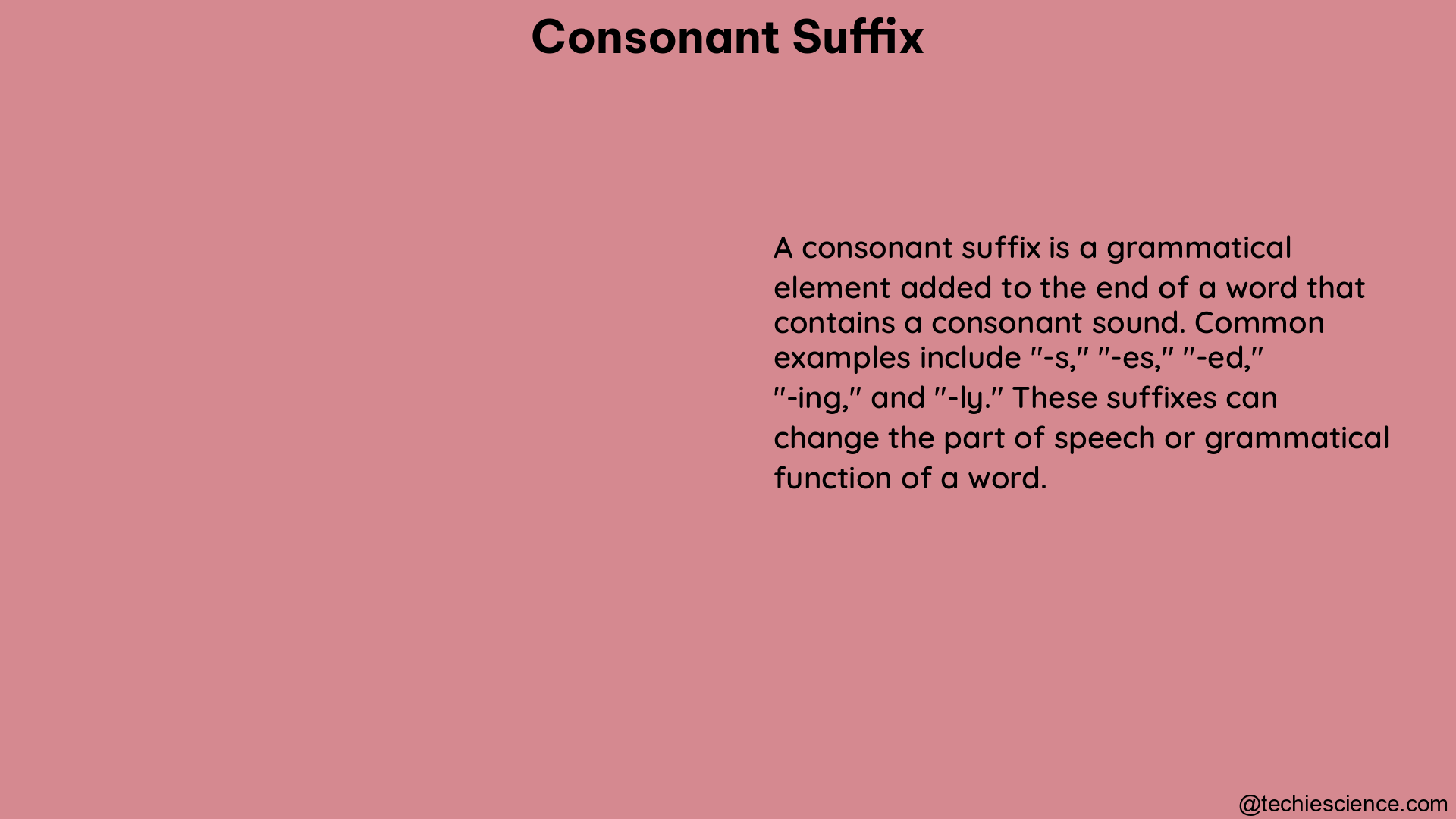Consonant suffixes are an essential part of the English language, allowing us to modify the meaning and function of words with ease. These suffixes, which begin with a consonant, play a crucial role in forming new words and altering the grammatical properties of existing ones. In this comprehensive guide, we will delve into the intricacies of consonant suffixes, exploring the rules for their application and the exceptions that challenge those rules.
Understanding Consonant Suffixes
A consonant suffix is a type of suffix that begins with a consonant sound. These suffixes are added to the end of a base word to create new words or change the grammatical function of the original word. Some common examples of consonant suffixes include -s, -ful, -less, -ness, -ly, -ship, -ment, and -y.
Rules for Adding Consonant Suffixes

Mastering the rules for adding consonant suffixes is crucial for ensuring accurate and consistent word formation. Let’s explore the key guidelines:
1. Adding a Consonant Suffix Directly
When adding a consonant suffix to a base word, you can simply attach the suffix without making any changes to the base word. This is the most straightforward approach.
Examples:
– hand + s = hands
– help + ful = helpful
– sleep + less = sleepless
2. Changing ‘y’ to ‘i’ Before Adding a Consonant Suffix
If the base word ends with a consonant followed by ‘y’, you need to change the ‘y’ to ‘i’ before adding the consonant suffix.
Examples:
– beauty + ful = beautiful
– duty + ful = dutiful
– happy + ness = happiness
3. Keeping the ‘e’ Before ‘-ment’
When adding the suffix ‘-ment’, you should keep the ‘e’ at the end of the base word if it is present.
Examples:
– achieve + ment = achievement
– argue + ment = argument
4. Exceptions to the Rules
While the rules mentioned above cover the majority of cases, there are some exceptions to be aware of. For instance, the ‘e’ is often kept when the word ends in ‘-ee’ or ‘-ye’.
Examples:
– agree + ing = agreeing
– eye + ing = eyeing
Consonant Suffix Examples
Now, let’s explore some common consonant suffixes and their functions:
| Suffix | Function | Example |
|---|---|---|
-s |
Forms plural nouns | cat + s = cats |
-ful |
Forms adjectives indicating fullness or completeness | help + ful = helpful |
-less |
Forms adjectives indicating the absence of something | sleep + less = sleepless |
-ness |
Forms nouns indicating a state or quality | happy + ness = happiness |
-ly |
Forms adverbs indicating manner or degree | quick + ly = quickly |
-ship |
Forms nouns indicating a state or condition | friend + ship = friendship |
-ment |
Forms nouns indicating a result or action | achieve + ment = achievement |
Advanced Considerations
While the rules and examples provided cover the majority of cases, there are some more advanced considerations to keep in mind when working with consonant suffixes:
-
Pronunciation Changes: In some instances, the addition of a consonant suffix can lead to changes in the pronunciation of the base word. For example, the word
electricbecomeselectricalwhen the suffix-alis added. -
Stress Shifts: The placement of stress within a word can also shift when a consonant suffix is added. For instance, the word
electrichas the stress on the second syllable, but when the suffix-alis added, the stress shifts to the third syllable, resulting inelectrical. -
Orthographic Changes: In rare cases, the addition of a consonant suffix can lead to changes in the spelling of the base word. This is often seen with words that end in a single consonant, where the final consonant is doubled before adding the suffix. For example, the word
stopbecomesstoppingwhen the suffix-ingis added. -
Irregular Forms: While the rules and patterns discussed in this guide cover the majority of cases, there are some irregular forms that do not follow the standard conventions. These exceptions must be learned and memorized, as they do not adhere to the typical rules.
Conclusion
Consonant suffixes are a fundamental aspect of the English language, allowing us to create new words and modify the grammatical properties of existing ones. By understanding the rules for adding these suffixes, as well as the exceptions to those rules, you can develop a strong foundation for effective and accurate word formation.
Remember, mastering consonant suffixes is an ongoing process, and the more you practice and apply these concepts, the more natural and intuitive they will become. Keep this guide as a reference, and continue to explore the nuances of the English language to further enhance your skills.
References
- SEARK Instructional Facilitation. (n.d.). Rules for Adding Suffixes.
- Avongrove. (n.d.). Fundations Unit 2.
- All About Learning Press. (n.d.). All About Spelling Level 3.
- Purdue Online Writing Lab. (n.d.). Suffixes.
- University of Chicago. (n.d.). Suffixes and Prefixes.
Hi… I am Sowndharya Jagadeeswaran, a university rank holder in M.A. English Literature. I have also done my master’s in Business Administration. Inquisitive as I am, my interest in action-oriented research helped me publish research papers in reputed journals. Now, as a career, I am an instructor where I teach young and adorable students the intricate technicalities of Public Speaking and Creative Writing. I also enjoy writing articles on topics I specialize and research in.
You can connect with me through LinkedIn.-